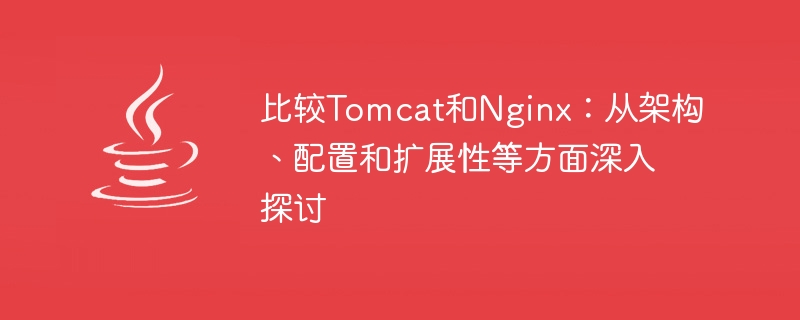

Comparing Tomcat and Nginx: In-depth discussion from the aspects of architecture, configuration and scalability
Introduction:
In the field of modern Internet technology, Web servers are An indispensable part. Tomcat and Nginx are two commonly used web servers and are widely used in the Internet. This article will deeply explore the differences and advantages and disadvantages between Tomcat and Nginx from three aspects: architecture, configuration and scalability, to help readers better understand and choose a web server that suits their needs.
1. Architecture comparison
Comparison:
Tomcat's architecture is more complex. Its original design is to provide a complete Java Servlet container and support Java Web development. Nginx, on the other hand, focuses more on high performance and high concurrency processing, and its architecture is simpler and lightweight. Therefore, if the project requires Java Servlet functionality or has higher performance requirements, Tomcat is a better choice; and for ordinary Web projects, Nginx can provide better performance and stability.
2. Configuration comparison
Comparison:
Tomcat's configuration is more cumbersome and requires manual writing in multiple configuration files. For developers unfamiliar with Tomcat, configuration and debugging can be difficult. The configuration of Nginx is relatively simple, and configuration and debugging can be completed quickly. Therefore, Nginx is easier to get started for developers who have simple needs or are not familiar with Tomcat.
3. Comparison of scalability
Comparison:
Tomcat is very scalable and can cooperate with various Java development frameworks to support more functions. Although Nginx does not have the powerful scalability of Tomcat, it can still achieve many needs by working with other servers. Therefore, if the project requires Java-related extended functions, Tomcat is the first choice; if the project has no requirements for Java-related functions, or pays more attention to performance and stability, Nginx is a better choice.
Conclusion:
In summary, Tomcat and Nginx have differences in architecture, configuration and scalability. Tomcat is suitable for projects that require Java Servlet functions or have higher performance requirements; Nginx is suitable for ordinary Web projects, with better performance and stability. For configuration and debugging, Nginx is simpler and easier to use. In terms of scalability, Tomcat's Java ecosystem is more complete and can meet more needs. Therefore, it is a wise choice to choose a suitable web server based on project needs and personal technical background.
The above is the detailed content of In-depth discussion of the architecture, configuration and scalability of Tomcat and Nginx. For more information, please follow other related articles on the PHP Chinese website!




